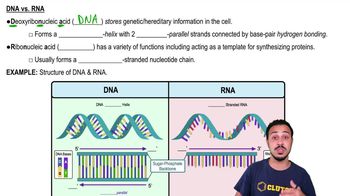Table of contents
- 1. Introduction to Biology2h 42m
- 2. Chemistry3h 40m
- 3. Water1h 26m
- 4. Biomolecules2h 23m
- 5. Cell Components2h 26m
- 6. The Membrane2h 31m
- 7. Energy and Metabolism2h 0m
- 8. Respiration2h 40m
- 9. Photosynthesis2h 49m
- 10. Cell Signaling59m
- 11. Cell Division2h 47m
- 12. Meiosis2h 0m
- 13. Mendelian Genetics4h 44m
- Introduction to Mendel's Experiments7m
- Genotype vs. Phenotype17m
- Punnett Squares13m
- Mendel's Experiments26m
- Mendel's Laws18m
- Monohybrid Crosses19m
- Test Crosses14m
- Dihybrid Crosses20m
- Punnett Square Probability26m
- Incomplete Dominance vs. Codominance20m
- Epistasis7m
- Non-Mendelian Genetics12m
- Pedigrees6m
- Autosomal Inheritance21m
- Sex-Linked Inheritance43m
- X-Inactivation9m
- 14. DNA Synthesis2h 27m
- 15. Gene Expression3h 20m
- 16. Regulation of Expression3h 31m
- Introduction to Regulation of Gene Expression13m
- Prokaryotic Gene Regulation via Operons27m
- The Lac Operon21m
- Glucose's Impact on Lac Operon25m
- The Trp Operon20m
- Review of the Lac Operon & Trp Operon11m
- Introduction to Eukaryotic Gene Regulation9m
- Eukaryotic Chromatin Modifications16m
- Eukaryotic Transcriptional Control22m
- Eukaryotic Post-Transcriptional Regulation28m
- Eukaryotic Post-Translational Regulation13m
- 17. Viruses37m
- 18. Biotechnology2h 58m
- 19. Genomics17m
- 20. Development1h 5m
- 21. Evolution3h 1m
- 22. Evolution of Populations3h 52m
- 23. Speciation1h 37m
- 24. History of Life on Earth2h 6m
- 25. Phylogeny2h 31m
- 26. Prokaryotes4h 59m
- 27. Protists1h 12m
- 28. Plants1h 22m
- 29. Fungi36m
- 30. Overview of Animals34m
- 31. Invertebrates1h 2m
- 32. Vertebrates50m
- 33. Plant Anatomy1h 3m
- 34. Vascular Plant Transport1h 2m
- 35. Soil37m
- 36. Plant Reproduction47m
- 37. Plant Sensation and Response1h 9m
- 38. Animal Form and Function1h 19m
- 39. Digestive System1h 10m
- 40. Circulatory System1h 57m
- 41. Immune System1h 12m
- 42. Osmoregulation and Excretion50m
- 43. Endocrine System1h 4m
- 44. Animal Reproduction1h 2m
- 45. Nervous System1h 55m
- 46. Sensory Systems46m
- 47. Muscle Systems23m
- 48. Ecology3h 11m
- Introduction to Ecology20m
- Biogeography14m
- Earth's Climate Patterns50m
- Introduction to Terrestrial Biomes10m
- Terrestrial Biomes: Near Equator13m
- Terrestrial Biomes: Temperate Regions10m
- Terrestrial Biomes: Northern Regions15m
- Introduction to Aquatic Biomes27m
- Freshwater Aquatic Biomes14m
- Marine Aquatic Biomes13m
- 49. Animal Behavior28m
- 50. Population Ecology3h 41m
- Introduction to Population Ecology28m
- Population Sampling Methods23m
- Life History12m
- Population Demography17m
- Factors Limiting Population Growth14m
- Introduction to Population Growth Models22m
- Linear Population Growth6m
- Exponential Population Growth29m
- Logistic Population Growth32m
- r/K Selection10m
- The Human Population22m
- 51. Community Ecology2h 46m
- Introduction to Community Ecology2m
- Introduction to Community Interactions9m
- Community Interactions: Competition (-/-)38m
- Community Interactions: Exploitation (+/-)23m
- Community Interactions: Mutualism (+/+) & Commensalism (+/0)9m
- Community Structure35m
- Community Dynamics26m
- Geographic Impact on Communities21m
- 52. Ecosystems2h 36m
- 53. Conservation Biology24m
18. Biotechnology
Introduction to DNA Cloning
Problem 2`
Textbook Question
Which of the following is true of a codon?
a. It never codes for the same amino acid as another codon.
b. It can code for more than one amino acid.
c. It can be either in DNA or in RNA
d. It is the basic unit of protein structure
 Verified step by step guidance
Verified step by step guidance1
Understand the definition of a codon: A codon is a sequence of three nucleotides in RNA that corresponds to a specific amino acid or a stop signal during protein synthesis.
Recall that codons are found in messenger RNA (mRNA) and are read during the process of translation to assemble amino acids into a polypeptide chain.
Analyze option (A): This is incorrect because multiple codons can code for the same amino acid due to the redundancy of the genetic code (e.g., both UUU and UUC code for phenylalanine).
Analyze option (B): This is incorrect because each codon specifies only one amino acid or a stop signal; codons do not code for multiple amino acids.
Analyze option (C): This is incorrect because codons are specifically found in RNA, not DNA. DNA contains triplets, which are transcribed into codons in RNA.
 Verified video answer for a similar problem:
Verified video answer for a similar problem:This video solution was recommended by our tutors as helpful for the problem above
Video duration:
1mPlay a video:
Was this helpful?
Key Concepts
Here are the essential concepts you must grasp in order to answer the question correctly.
Codon Definition
A codon is a sequence of three nucleotides in DNA or RNA that corresponds to a specific amino acid or a stop signal during protein synthesis. Codons are essential for translating genetic information into proteins, as they dictate the order in which amino acids are assembled.
Recommended video:
Guided course

How to Use the Genetic Code
Genetic Code
The genetic code is the set of rules by which information encoded in genetic material is translated into proteins. It is nearly universal among organisms and consists of 64 codons that specify 20 amino acids, allowing for redundancy where multiple codons can code for the same amino acid.
Recommended video:
Guided course

Genetic Code
Difference Between DNA and RNA Codons
Codons can be found in both DNA and RNA, but they play different roles in the two types of nucleic acids. In DNA, codons are transcribed into mRNA, which then carries the genetic information to ribosomes for translation into proteins. This distinction is crucial for understanding the flow of genetic information.
Recommended video:
Guided course

DNA vs. RNA

 2:25m
2:25mWatch next
Master Introduction to DNA Cloning with a bite sized video explanation from Jason
Start learningRelated Videos
Related Practice







![[LECT C8 : RECOMBINANT DNA TECHNOLOGY] 8.2 Steps in Gene Cloning](https://img.youtube.com/vi/T1l-StLrDwg/mqdefault.jpg)

